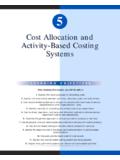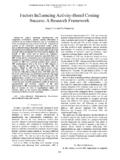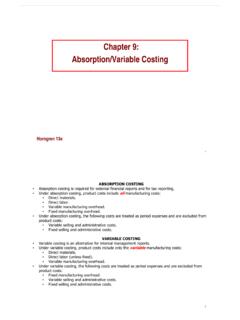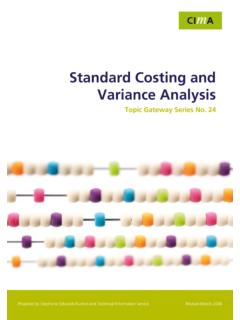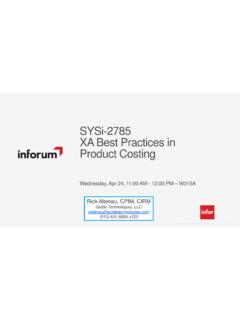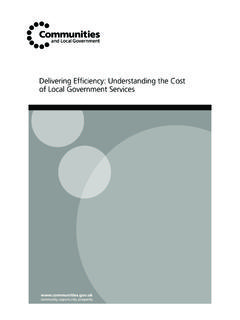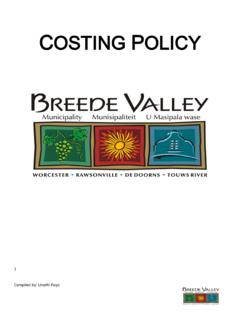Transcription of Costing Human Resources - gccaonline.com
1 Costing Human ResourcesThe Financial Impact of Behavior in OrganizationsWayne F. CascioCosting Human Resources First recognized approach was developed by Barry Corp. of Columbus OH in 1967. Department managers measured on five costs: Recruiting Acquisition Formal Training Informal Training Development People are our most valuable asset. Asset Based Strategies Historical Cost Replacement Cost Present Value of Future Earnings Value to the OrganizationHistorical Cost Assets are placed on the books at acquisition cost. Assets are depreciated of their anticipated useful life. Maintenance costs for the assets are expensed during each operating Cost A reasonable substitute for market value.
2 Confounded by cost of acquisition (inefficient hiring). Often, turnover is low enough to make replacement cost only an educated guess. A projection of a person s future compensation in today s dollars. Limited by forecasting the contribution based on average output. Limited by measuring worth as cost, not contribution to revenue or Value of Future Earnings Value is determined by internal competition of managers to obtain services of that individual. Difficult to to the OrganizationStrengths/Weaknesses Investment is tracked and is appropriate for external reporting. Dollar is not stable over time. Write-offs of failed programs is subjective.
3 People, as assets, are not saleable, value is not confirmed in the marketplace. Only costs are measured, not value to the current organization. People are thought to gain value with experience. People measures are usually behavioral and statistical, rather than financial. Economic measures of people are typically cost-based, rather than asset Costing Effective measurement must include the value of employee output, as well as s ApproachBehavioral Costing Effective measurement must include the value of employee output, as well as cost. Effective measurement must include variability of output and cost by individual and s ApproachBehavioral Costing Effective measurement must include the value of employee output, as well as cost.
4 Effective measurement must include variability of output and cost by individual and group. Many organizations do not want to measure and be accountable for how well they manage s Approach Focus on dollar value of behavioral outcomes in s ApproachBehavioral Costing Focus on dollar value of behavioral outcomes in organizations. Do not focus on the value of the individual, but on the economic consequences of s ApproachBehavioral Costing Focus on dollar value of behavioral outcomes in organizations. Do not focus on the value of the individual, but on the economic consequences of behavior. This is an expense model, not an asset s ApproachBehavioral Costing Outlay costs (materials) + Time costs (supervision) Fixed (independent of output) + Variable (dependent on output) + Opportunity (alternative use of resource )Two ConsiderationsBehavioral CostingBehavioral CostingRest RoomsParkingTime ClocksWagesFreezer GearAutomationHR StaffGovernment ReportingSupervisorsCustomer ServiceOutlayTimeFixedVariableOpportunit y No methods of measurement.
5 Top management believes the cost is unquantifiable. Some managers want to avoid measurement. Past efforts have Costing Compensation Programs Benefits Personnel Taxes Recruiting and Training Affirmative Action/Selection Turnover SafetyCost Impact CategoriesBehavioral CostingTurnoverTurnoverTurnover = (Separations/Average Work Force Size) X 100 VoluntaryInvoluntaryEmployee ConductEmployer OperationsCost of Turnover =Separation Costs+Replacement Costs+Training CostsTurnover Exit Processing $ 35 Plant Staff (1x$25) Payroll (.5x$20) Separation Pay$ 0 Unemployment Tax Impact$ 6,750 20 Weeks x $320 ESD, WA 2011 Separation CostsTurnover Communication of Vacancy $ 85 Pre-employment Admin (2x$25)$ 50 Selection Interviews (.)
6 5x$100)$ 50 Testing Fit for Duty + Drug $ 170 Orientation (1x$25)$ 25 Relocation Expense$ 0 Replacement CostsTurnover Materials - Books$ 30 Equipment - Boots$ 75 Formal Training (4x$150)$ 600 Training Wages (32x$ )$ 376 OJT Observation (12x1x$30)$ 360 Training CostsTurnoverCost of Turnover =Separation Costs$6,785+Replacement Costs$ 380+Training Costs$1,441----------------------------- -------------Total$8,606 TurnoverCost of Turnover =Average Work Force420 XTurnover Costs$8,606----------------------------- -------------Total$542,178 TurnoverDifference in Performance =Pay:(RateLeaver RateReplacement) X Hours Productivity:(RateLeaver RateReplacement) X Cost/UnitTurnover Realistic Job Preview Performance Testing Training Payback Plans.
7 Airlines Pre-Employment Training Program Job EnrichmentRemediesTurnoverJob Enrichment Hackman & Oldham Job Diagnostic Survey Travelers Insurance, data entry workers High internal work motivation High work performance High work satisfaction Low absenteeism and turnoverExpected Outcomes Experience meaningfulness of work Skill Variety Task Identity Task Significance Responsibility for work outcomes Autonomy Knowledge of work results -FeedbackJob Enrichment Combining TasksSkill Variety Natural Work UnitsTask Identity Client RelationshipsTask Significance Vertical LoadingAutonomy CommunicationFeedbackJob EnrichmentAbsenteeismAbsenteeismCost of Absence =Hours X (Sick Pay + Benefits)
8 Hours X Replacement Wage Staff Costs Difference in PerformanceCost of Absence = @2% $708/employee40 Hours X ($0 Sick Pay + $7 Benefits) 40 Hours X .5 X $17 Replacement Wage 5 X .2 X $20 Staff Costs 40 X .1 X $17 Difference in TIME TIME Wage (Pounds/Hour) = Cost/CWT Pay for Longevity can be a cost trap. Standard Deviation $.02/CWTP roductivity05101520253035< >3 Productivity$12$13$14$15$16$1760%70%80%9 0%100%110%120%130%Output$$12$13$14$15$16 $17$1870%80%90%100%110%120%130%140%Outpu t$ProductivityAttitudes Attitudes have 3 elements: Cognition Knowledge of the focal object Emotion Feeling toward the focal object Action Tendency Readiness to respond Attitude Behavior Outcome Performance = Attitude X KSAO sAttitudes One method of Costing uses correlations between attitude survey response and unit cost of production Weaknesses.
9 Vulnerable to confounding variables Attitude-Behavior relationships may not be stable over time Survey to measure: Job satisfaction Job involvement Employee intrinsic motivation Measure performance: Attendance/Turnover/Error/Output Determine correlation between attitude and performanceAttitudes Develop an OD project to improve attitudes Value of OD Project = r X SDPerformanceX SDAttitude = Output Output X Cost/Unit = $$$$$AttitudesAttitudesExample:Motivatio n Mean 70, SD 10 Performance Mean 8,000, SD 700 Correlation r = . X 700 X .5 = 70 Pounds / Hour70 X 1,800 X $.0021 = $265 AttitudesTraining Kirkpatrick Model Reaction Did participants appreciate it?
10 Learning Did participants gain skill? Performance Did on the job behavior change? Results Did the behavior change produce economic benefit? What is the duration of the benefit? What is the cost of the training?Further Study Performance Management Dr. Aubrey C. Daniels Analyzing Performance Problems Dr. Robert F. Mager Human Potential Accounting Dr. Michael ReddyQuestions?

